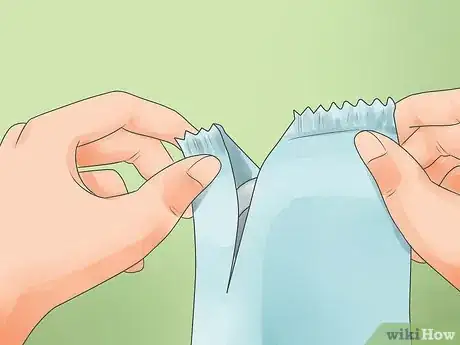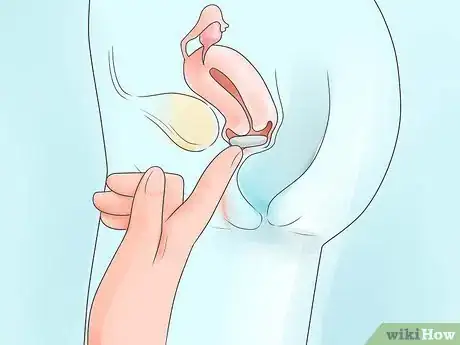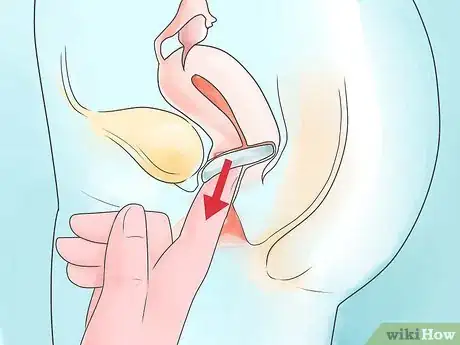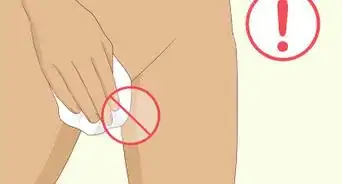wikiHow is a “wiki,” similar to Wikipedia, which means that many of our articles are co-written by multiple authors. To create this article, volunteer authors worked to edit and improve it over time.
There are 7 references cited in this article, which can be found at the bottom of the page.
This article has been viewed 299,679 times.
Learn more...
Pessaries are medical devices inserted and worn in the vagina. They support the vaginal wall and help correct the position of displaced pelvic organs. You can usually insert and remove a pessary on your own, but you will still need to see your doctor for regular examination and maintenance of the device.
Steps
Insertion
-
1Wash your hands. Wash your hands with warm water and soap. Dry them with clean paper towels once clean.[1]
-
2Remove any wrappings. Remove the pessary from any foil or plastic wrappings. If the pessary does not come in sterile packaging, you should wash it with soap and water. Rinse and dry thoroughly.
- Note that pessaries come in different sizes. Your doctor should supply you with a pessary based on the size he or she determines you'll need.[2]
Advertisement -
3Fold the pessary in half. Grab the pessary on either side of the knob and use your fingers to fold the ring in half.[3]
- Examine the pessary closely. If you're using an open ring pessary, you should see notches along the inside. If you're using a ring-with-support pessary, you should see openings along the center support structure. Both of these areas are the flexible points you will need to fold, and you should grab the ring in between these points. The pessary should only be able to fold in these areas.
-
4Apply water-based lubricant to the pessary. Use your fingers to apply a small dab of lubricant to the end of the ring without the knob.[4]
- Note that the curved portion should face upward, toward the ceiling, as you hold the pessary.
- The lubricant should be applied over the entire folded end of the pessary on the opposite side of the knob. This edge is the edge you'll be inserting first.
-
5Keep your legs apart. Stand, sit, or lie down with your legs apart. The pessary can be inserted from any of these positions, so use whichever feels most comfortable to you.[5]
- If you choose to sit or lie down, your knees must be bent and your legs should be spread apart as far as possible without causing discomfort.
- If you choose to stand and are right-handed, place your left foot on a chair, stool, or toilet with your right foot on the ground. Lean over your left leg while inserting the pessary.
- If you choose to stand and are left-handed, place your right foot on a chair, stool, or toilet with your left foot on the ground. Lean over your right leg while inserting the pessary.
-
6Spread the labia. Use the fingers of your non-dominant hand to spread apart the lips of the vagina.[6]
- You should still have the folded pessary in your dominant hand. Use your dominant hand to insert the pessary.
-
7Gently insert the pessary. Carefully push the folded, lubricated end of the pessary into the vagina. Push it back as far as possible without causing discomfort.[7]
- Note that the pessary should be inserted lengthwise into the vagina.
-
8Release the pessary. Let go of the pessary. As you do, it should unfold and return to its normal shape.[8]
- If the pessary does not feel comfortable, use your index finger to rotate it. The knobbed end should face upward, and you should not be able to feel a pessary once it has been properly positioned.
-
9Wash your hands again. Remove your hands from your vagina and wash them again with soap and warm water. Dry well with clean paper towels.
- This completes the insertion process.
Care
-
1Check the fit. A properly fit, properly placed pessary should not feel uncomfortable. In fact, it should hardly be felt at all.[9]
- You should also check the fit by bearing down or attempting to use the bathroom. The pessary should not fall out during either action, and you should not have any difficulties using the bathroom after placement.
- If altering the placement of your pessary does not resolve any discomfort or other problems, the pessary may not be the right size or style. You will need to consult your doctor at this point.
-
2Clean the pessary regularly. You should remove the pessary at least once a week and clean it before inserting it back into place.[10]
- Ideally, you should remove the pessary and clean it once a day. Some women may even choose to remove it at night, clean it, and re-insert it in the morning, but you should check with your doctor to verify that leaving it out overnight is acceptable for your condition.
- When cleaning the pessary, use mild soap and warm water. Rinse the device and dry it with clean paper towels before inserting it again.
- If you are unable to easily remove and insert the pessary on your own, you should go to the doctor every three months for professional examination and cleansing. Never leave a pessary in for more than three consecutive months without cleaning it.
-
3Clean the pessary if it falls out. While you should be able to urinate without difficulty, the pessary may fall out during a bowel movement. If it does, you will need to clean it thoroughly before inserting it again.
- Check the toilet after each bowel movement to determine whether or not the pessary has fallen out.
- If the pessary did fall out, scrub it clean with mild soap and hot water. Allow the pessary to soak in rubbing alcohol for 20 minutes, then soak the device in clean water for another 20 minutes. Wash it once more with soap and water, rinse it, then dry it before inserting it into the vagina again.
-
4Schedule frequent appointments with your doctor. Even if you are able to remove, clean, and insert the pessary at home, you should still schedule an examination with your doctor every three to six months.
- Your first examination should actually be after two weeks or so. Your second examination should occur within three months after that.
- Continue seeing the doctor every three months until a full year passes. After using the pessary for a full year, you can usually schedule an examination for only two or three times a year.
Removal
-
1Wash your hands. Before removing the pessary, you should wash your hands with mild soap and hot water. Dry them thoroughly with clean paper towels.[11]
-
2Hold your legs apart. Position your legs apart while standing, lying down, or sitting. You should be able to use the same position used while inserting the pessary.
- Remember to keep the legs apart and the knees bent. If standing, place your non-dominant foot on a stool and lean over that leg during the removal process.
-
3Insert your finger. Insert your index finger into your vagina and locate the rim of the pessary. Hook your fingertip under or over the rim.[12]
- More precisely, you should locate the knob, notch, or opening along the rim and hook your finger into that.
- Note that the pessary should be just beneath the pubic bone.
-
4Tilt and pull down. Use your finger to tilt the pessary slightly, then gently pull it down until it slides out of the vagina.[13]
- You should only need to tilt the pessary by about 30 degrees.
- Folding the pessary may help you remove it, but it will not fold as completely as it did during insertion. The vaginal walls should usually stretch adequately well for you to remove the device even without folding it, however.
- If you have difficulty sliding it out, bear down as though you are having a bowel movement. This action can help push the rim of the pessary forward, making it easy to grab and pull out.
-
5Wash your hands again. After removing the pessary, you should wash your hands again using hot water and soap. Dry well.
- Clean or discard the pessary as needed after removing it.
- This step completes the removal portion of the process.
Warnings
- Use sanitary napkins instead of tampons during your period to prevent discomfort and potential interference.⧼thumbs_response⧽
- Some pessaries may damage condoms and diaphragms, making them ineffective forms of contraception. Talk to your doctor if you have any concerns about this.⧼thumbs_response⧽
- Contact your doctor if the use of a pessary causes vaginal bleeding, foul-smelling vaginal discharge, pelvic pain, pelvic pressure, difficulty urinating, difficulty with bowel movements, vaginal irritation/itching, unusual discomfort (swelling, tenderness, cramping, or pain) in the lower abdomen, or fever.⧼thumbs_response⧽
Things You'll Need
- Pessary
- Water-based lubricant
- Water
- Mild soap
- Paper towels
- Rubbing alcohol (as needed)
References
- ↑ http://www.med.umich.edu/1libr/Gyn/InsertingAndRemovingAPessary.pdf
- ↑ https://www.ncbi.nlm.nih.gov/pmc/articles/PMC1949074/
- ↑ http://www.webmd.com/urinary-incontinence-oab/video/pessary-insertion
- ↑ http://www.med.umich.edu/1libr/Gyn/InsertingAndRemovingAPessary.pdf
- ↑ http://www.brighamandwomens.org/Departments_and_Services/obgyn/Services/urogynecology/pessary.aspx
- ↑ https://www.ucsfhealth.org/education/pessaries/
- ↑ https://www.ucsfhealth.org/education/pessaries/
- ↑ http://www.med.umich.edu/1libr/Gyn/InsertingAndRemovingAPessary.pdf
- ↑ https://www.health.qld.gov.au/__data/assets/pdf_file/0027/677025/care-of-your-vaginal-pessary.pdf
About This Article
Before you insert a pessary, wash your hands with soap and water and dry them with a clean towel. Then, grab the pessary on both sides of the knob, use your fingers to fold the ring in half, and apply a water-based lubricant to the end of the ring without the knob. Next, find a comfortable position sitting, standing, or lying down. You can then use the fingers on one hand to spread your labia while you gently insert the folded, lubricated end of the pessary into your vagina with the other hand. Push the pessary as far back as you comfortably can, then let it go. To learn when and how to clean your pessary after it’s in, keep reading!












































































Medical Disclaimer
The content of this article is not intended to be a substitute for professional medical advice, examination, diagnosis, or treatment. You should always contact your doctor or other qualified healthcare professional before starting, changing, or stopping any kind of health treatment.
Read More...